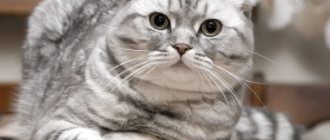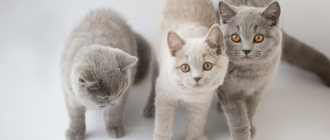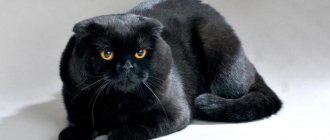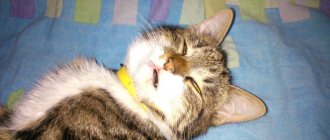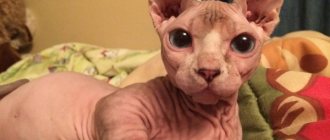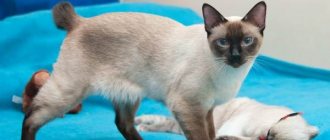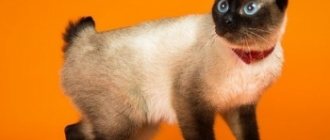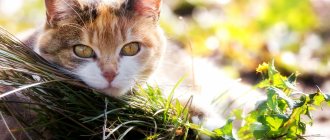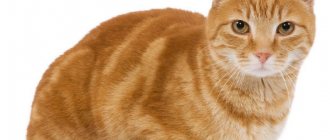- Pets
- >>
- Cat breeds
* Here is a photo of a typical representative of the Scottish Fold cat breed . You can send us photos of your animals by email, and we will post them on the website. Don't forget to send your pet's name.
Origin
Many years ago, in a Scottish village, there lived a cat named Susie. She was not particularly outstanding or noticeable. An ordinary village cat who caught mice in the barn, drank milk from a saucer and gave birth to kittens. It was the descendants who made Susie famous. Oh yes, the cat had unusual ears. Folded, curved down and quite small. But the owner was not interested in her ears. Performs its functionality, and, thank God.
As time passed, the cat brought kittens. One such litter was born from a neighbor's cat, a very ordinary village warrior. Among her brothers and sisters, a cute cat stood out. She inherited her mother's ears. To the farmer-owner, the lack of crumbs did not seem touching. It appeared only when the baby grew up. She was three weeks old. Susie's owner decided to get rid of his second handicapped cat.
If this had happened, the world would never have known about the Scottish breed. Reviews about the Scottish Fold cat are the most wonderful: she is known and loved all over the world.
The kitten is lucky. A familiar cat herder came to visit the farmer. He was very fond of fluffy purrs and was seriously interested in breeding them. The shepherd liked the unusual cat. He bought her, named her Snooksy and raised her.
In 1963, Snooksy gave birth to her first litter. The father of the kittens was a cat of the British breed. Upon further study of her offspring, it became clear that the lop-eared gene was dominant in them. Another reward from Grandma Susie was long hair. In order to consolidate the “ear zest”, the first kittens were crossed with each other. Subsequently, British cats took part in breeding. Thus, the world received the Scottish Fold, in reviews of which you can hear many flattering words.
History of the origin of Scottish Fold cats
The Scottish Fold breed appeared relatively recently, about 50 years ago. The ancestors and main relatives of Scottish Fold cats are British Shorthair cats. Despite the fact that the ancestors of animals of this breed were short-haired, the first kittens of this breed had mostly long hair. The first kitten known to the world was bought by Valery Ross in 1961 on a farm in the Scottish city of Tayside.
The kitten was unique in its own way; it had unusual ears that hung forward. The kitten's mother, the cat Susie, was the very first representative of this breed and gave such beautiful offspring. In 1973, kittens of this breed went to the famous cat breeder Sally Wolfe Peters, and this breed attracted public attention.
In 1978, cats of the Scottish breed participated in cat shows and received the status of the Cat Fanciers' Association. More and more people wanted to get such cute pets, however, for a long time they did not dare to breed cats of this breed in nurseries, and even a ban was introduced on the breeding of cats of this breed. This prohibition is due to the fact that if you cross a cat and a cat of the fold breed, offspring will be born with disorders in the musculoskeletal system.
Such animals cannot live a full life. The breed can only exist by crossing lop-eared individuals with individuals with straight ears. When these recommendations are followed, healthy fold-eared offspring are born. In 1993, the CFA adopted a standard corresponding to this breed.
Peculiarities
It all starts with the pet's appearance. These unusually curved ears, almost pressed to the head, coupled with huge expressive eyes, have become the hallmark of the breed.
Another feature is the refusal to recognize the Scottish Fold as a separate breed in its own homeland. This is due to the concerns of felinologists regarding the ears of animals. Many cat experts believe that sooner or later, such a mutation will play a bad role for the representatives of the breed.
The character of the Scottish Fold, according to reviews, is very surprising. Aristocrats talk about such cats. Representatives of the breed definitely have blue blood flowing through them. Otherwise, how to explain their tact and almost complete lack of aggression towards their own offenders?
Standards
There are 2 standards: European and American. They are almost the same, the only difference is that European Scottish Folds have a more massive skeleton and ears that do not fit so tightly to the skull.
| Standard | Description |
| Head | Round, with a massive chin and plump rounded cheeks. The forehead is high, level, the nose is short and fairly wide. |
| Ears | Small, widely spaced. Their tips are rounded, and the ears themselves bend forward and down. At the same time, the standard requires that the ears do not extend beyond the contour of the head. |
| Eyes | Large, round. The iris should be in harmony with the color of the coat. |
| Torso | Strongly built, with pronounced muscles and a well-developed chest. The neck is dense and short. |
| Limbs | Medium length, paws small, round. |
| Tail | Wide at the base, tapering towards the tip. |
| Wool | The coat is thick and elastic. Since it does not fit tightly to the body, it is fluffy in appearance. |
Loop ears are conventionally divided into 3 groups: single (when only the tips of the ears are bent), double (when the auricle is bent, and a gap is visible between the head and ears) and triple (the ears are pressed so tightly to the skull that one gets the impression of their complete absence).
Appearance
Reviews of the Scottish Fold cat say that representatives of this breed are large. Males can weigh around 10 kg, although the beautiful ladies are much lighter.
The body of the animal resembles a square when viewed from the side. At the same time, cats are not fat at all, they just have well-developed muscles. The head is wide, oval, the ears are pressed tightly against it. The muzzle is round, rather plump cheeks. The eyes are very large, resembling a sphere.
The paws of the Scottish Fold, according to reviews, are quite strong and powerful. Another highlight is the animal’s fur: it is short, fits tightly to the body, and feels like plush to the touch.
The color of representatives of the breed can be different: from smoky to tabby or color point. Eye color depends on coat color. White cats can have blue or multi-colored eyes.
BRITISH AND SCOTTISH CATS: INTERBREED MATING OF “BRITISH FOLD” IS PROHIBITED
British and Scottish cats have the same roots; mating between them was allowed at a certain period of time. The Scots Fold and the British mated with each other until 2004. This was done according to mutually beneficial calculations: the British received new and interesting colors from their Scottish counterparts, and the Scots, in turn, acquired the plush and thick fur, as well as the massiveness of the British breed. Read more about the differences between the British and the Scots here.
However, in 2004, a decision was made to stop interbreed matings due to the fact that both breeds began to suffer. The Scottish breed began to have bone problems. And British cats lost the beauty of their fur, their bodies became longer, their faces became smaller. Since then, matings between Scottish and British cats have been prohibited, and “British Fold kittens” are not recognized by either system. The British breed is closed, and matings are allowed only within this breed. In addition, many veterinarians speak strictly negatively about such crossing.
As a result of crossing two different breeds and obtaining a “loose-eared British kitten,” it immediately acquires the status of outbred and suffers due to breed characteristics.
Character
Reviews about the character of the Scottish Fold cat are generally positive. These animals are very interesting in character. They are affectionate, but at the same time they choose one owner. Some will say that this cannot happen. Everyone knows that cats walk on their own. They, unlike dogs, do not become attached to people. But not representatives of the Scottish breed. This is a one-owner cat, no matter how strange these words may sound. Only to him will she trustingly begin to purr her songs. Only he will come to him and lie on his knees. And only he can scratch her tummy with impunity.
This does not mean at all that the family’s favorite does not like the rest of its members. No, that's not true. The Scottish Fold cat, according to owners' reviews, is patient with children. She calmly plays with them, but if the baby really starts to bother the pet, then she is able to delicately hint at this. Hit your hand with your paw without letting go of your claws, or lightly bite the annoying one. And all this is done very delicately, so as not to harm the little owner.
The pet does not like being openly forced upon him. That’s why she tries to run away from the overly insolent guests who decided to cuddle the big-eyed beauty.
Description of Scottish folds
Adult Scottish Fold cats are medium in size, with adult males being larger than female cats. The body is slightly elongated and this differs from the stocky type of British cats. The animals' shoulders and hips are the same width. The chest stands out for its volume and considerable width for cats of this size. True Scottish Folds never look fat or clumsy. Their movements are always graceful and easy. The length of the limbs ranges from medium to long. But the paws themselves are noticeably round and graceful.
On average, Scottish Fold cats live 10-15 years
Tail
medium length, it should be proportional to the body.
The tail begins with an expanded base and ends with a blunt tip. Sometimes Scottish Fold kittens have thick and fluffy tails. This feature is accompanied by thickened hind limbs, which affects the gait of the animal. At the dawn of the breed, these signs were considered positive. However, over time, such cats were no longer allowed into exhibitions. Animals with a flexible, movable tail are especially valued in the Scottish breed. This requirement is dictated by the fact that Scottish Fold cats often have joint problems.
Scottish fold cat head
round with well-developed jaws and a strong, rounded chin. The round cheeks on the muzzle catch the eye, which are more pronounced in cats than in cats. The head smoothly turns into a short neck.
Nose
short and wide. At the same time, there may be some slight depression at the junction of the nose and the frontal part. But there is no characteristic “stop”, only a soft bend, noticeable in profile.
Eyes
true Scots have widely spaced, clear rounded shapes. An open look is characterized by expressiveness. In purebred cats, the brow ridges are weakly expressed. If they are well developed, the animal may be disqualified.
Scottish fold cat ears
are the main feature in the breed standard.
The maximum requirements are placed on them. The distance between the left and right ears is quite large - in an adult cat it can be equal to the width of a human palm, and in kittens it can be the width of 3-4 fingers. The ears themselves are small in size and have one, two or even three folds. Due to this, the outer part of the ear is tilted forward and significantly closes the ear canal. By keeping the ears flat, the round shape of the head is maintained. This gives Scottish Folds a cute and slightly doll-like appearance. global $ads_google;
//data-ad-slot=”2475549904″ $ads_google = empty($ads_google) ? false : true; ?> if ($ads_google == false) {?> $ads_google = true; ?> } ?> All Scottish Fold kittens are born with straight ears. It is impossible to determine what an adult pet will be like because babies' ears continue to stand up for several weeks after birth. The shape of the auricle, which is genetically determined, is finally formed only by the age of five weeks. It is worth noting that the more the ears are pressed back, the more their owner is valued in professional circles.
The standard allows wool
short and medium length. The quality is thick, elastic and dense. The skin is soft and elastic to the touch. It is often called plush. But if the animal’s fur is cottony, then this is considered a defect in the breed. The so-called “pants” and thick hairs between the toes on the paws are considered a breed characteristic.
Scottish Fold cats can be any color.
This is one of those breeds for which almost all color options are allowed. Often there are cats of a saturated or lightened shade, but at the same time the same color. Table of popular Scottish Fold colors
| white lilac blue chocolate silver blue cinnamon black | gray peach mackerel fawn smoked silver blue point | red merle color-point cream whiskey chinchilla brown |
The population has multi-colored representatives (harlequin and li van). The Scottish Fold cat with stripes is not considered a rarity. The nature of the drawing may be different:
- tabby;
- spotted;
- marble;
- brindle.
- ticked
- tortoiseshell
Dimensions and weight of fold cats
When born, a small kitten weighs only 65-150 grams and is the size of a palm. Babies require careful care until they get stronger and become independent.
The body length of adult cats and shorthair fold cats is on average 50-55 cm, excluding the length of the tail. With a tail, the size of fold-eared cats can reach 80-90 cm; according to the exhibition standard, it should reach the shoulder blades if folded lengthwise.
The height can reach approximately 29-32 cm when counting from the floor to the withers of a cat standing on four legs.
These sizes are considered average among domestic cats.
Don’t forget about these pet parameters when you are planning to buy accessories: house, carrier, closed tray.
Scottish Fold weight table by month
| Age | Cat | Cat |
| newborns | 65-150 gr | 60-140 gr |
| 1 Week | 230-285 gr | 110-265 g |
| 2 weeks | 330-430 gr | 130-350 gr |
| 3 weeks | 400-630 gr | 210-430 gr |
| 1 month | 430-750 gr | 230-610 g |
| 2 months | 820-1750 gr | 420-950 gr |
| 3 months | 1.5-2.5 kg | 1-1.5 kg |
| 4 months | 2.6-3.9 kg | 1.6-2.4 kg |
| 5 months | 2.7-4.3 kg | 2.1-2.9 kg |
| 6 months | 3-5.4 kg | 2.3-3.6 kg |
| 7 months | 3.3-5.7 kg | 2.4-4 kg |
| 8 months | 3.4-6.1 kg | 2.5-4.3 kg |
| 9 months | 3.8-6.5 kg | 2.5-4.4 kg |
| 10 months | 4.1-6.7 kg | 2.5-4.5 kg |
| 1 year | 4.3-7.3 kg | 2.5-4.7 kg |
| 2 years | 4.3-8.1 kg | 2.5-6 kg |
Compatibility with other animals
According to owners, the Scottish Fold is very patient with dogs. In the event that a puppy was brought to her. But he doesn’t particularly favor his brothers from the cat clan. Of course, when both cats are kept together from early childhood, it is a different matter. They get along fine with each other. But if you bring a second kitten to a house where a Scottish Fold already lives, she is unlikely to appreciate it. Conflicts most likely cannot be avoided.
Breeding Scottish Fold cats
Breeding Scottish cats is a very complex process since these cats have problematic genes, the manifestation of the negative consequences of these genes can only be avoided by selecting a pair. By the way, it’s exactly the same story with Munchkin cats. Fold-eared cats are never bred with a fold-eared partner, since in this case offspring are born with serious genetic diseases of the musculoskeletal system. Cats of the Scottish Fold and Highland Fold breeds are crossed exclusively with the straight-eared Scottish Straight and Highland Straight, only with such mating the offspring are born healthy.
Cats are ready for mating at the age of one and a half years. You cannot breed cats during their first heat; you must wait until the second, or better yet, the third. It is also worth remembering that a cat can become pregnant on the second or third day of estrus. The first mating process is quite complicated, and nature does not always tell cats what to do. If the cat has not interacted with her own kind before, the process of the first mating can be very complicated. In this case, cats begin to show aggression towards their partner, hissing and growling menacingly.
Even if the cat behaves calmly, she can simply lie on her side and not let the cat near her. Mating of Scottish cats should always take place in the male's territory. In this case, the male feels completely safe and can spend all his energy courting the cat. The cat's owners are only required to correctly calculate the day when to produce it, and provide the cat with its usual food and litter tray for the mating period.
Mating usually takes 2-3 days. On the first day, the animals get to know each other, adapt and form sympathy. Mating occurs on 2-3 days. During the mating period, cat owners must allocate a separate room for the cats, where no one will disturb them, and the area must be closed so that the guest cannot escape. Cat mating games go something like this: the male settles down at a short distance from the cat and does not show any attention, sometimes he comes closer to the female, but she scares him off with a menacing hiss.
Later, the cat pretends to be asleep and doesn’t care about the female at all. Discouraged by the lack of attention, the cat begins to roll on the floor and meow, calling for a male. When the cat begins to show interest, the cat becomes aggressive again. This is repeated over and over again until the cat gets bored and stops resisting. Sexual intercourse in cats lasts about 5-10 seconds. About 10-16 matings occur within a few days.
The main signs of pregnancy in a cat:
- Morning sickness;
- The cat's nipples become swollen;
- The cat's appetite increases greatly;
- Character changes;
- The animal becomes more nervous;
- The cat may be aggressive;
- At the end of the second week of pregnancy, the fetuses can be felt by palpation;
- A cat's pregnant belly appears towards the end of the 6th week of pregnancy.
Pregnancy in Scottish cats lasts approximately 9 weeks. One litter usually produces 4 kittens.
Content
The advantages of the Scottish Fold cat, according to reviews, are character, appearance and relative unpretentiousness. Your beauty will need:
- A house where she could stay alone. Or at least your own bed.
- A scratching post is a must for keeping. These cats will not sharpen their claws on walls or doorposts, like other members of the family.
- Tray with filler. Scottish Folds are big neaties. You need to clean up after them every time the cat does its business. Representatives of the breed will refuse to go to a dirty toilet.
- Bowls for food and water. It is better to buy heavy dishes that your pet cannot turn over. Take a metal bowl under water.
- Complete food. This could be natural food or good dry food.
- Toys. All kinds of mice, balls and other entertainment for pets.
Care
Reviews of the Scottish Fold say that it is not particularly demanding in care. The only thing she needs is regular examination by a veterinarian. These cats do not shine with good health.
How to care for your pet? It all starts with the owner checking the general condition of the animal every morning. Examines eyes, ears, mouth and fur. The eyes should be clear and shiny, without any discharge. If the ears are dirty, then wipe them with a cotton swab dipped in a weak solution of vinegar (1:1 percentage ratio) or a special hygiene product that can be bought at any veterinary store.
To avoid the formation of tartar, it is recommended to brush your cat’s teeth daily. For this purpose, there are special toothpastes for cats and elongated brushes.
Wipe the eyes with a cotton swab to remove any discharge.
Representatives of the breed have their nails trimmed once every 3-4 weeks. If the owner is afraid to carry out this procedure on his own, then veterinary clinics have not yet been canceled.
Brush your Scottish Fold cat every week, and if you have a long-haired representative of the breed, then once every two days. During molting, your pet's toilet will have to be monitored daily.
Breeding and choosing a British kitten
British kittens are born healthy and strong, grow quickly and eat actively. It is recommended to buy a pet at the age of 1.5-2 months. During this period, the kitten weans the habit of breastfeeding, gains strength and is emotionally ready to move. British cat price depends on the availability of documents and pedigree. If you plan to participate in exhibitions and engage in breeding, then the kitten must have the appropriate documents. If you want to buy a pet “for yourself,” then you can choose kittens without “papers,” which, by the way, will significantly reduce the price (by 3-4 times).
Photo: British kittens
When breeding kittens, mating must be done at the age of 1 year. The key point is the right choice of partner. The cat must belong to the same breed as your pet. In this case, the color of the animals must be identical or very close. When mixing colors, the color of the kittens turns out to be uneven.
The genetic factor should also be taken into account. Mating of straight-eared pets is permissible only with representatives of fold-eared cats. A pet's pregnancy lasts about 9 weeks, and the first signs appear after 10-15 days: increased appetite, a peaceful state, swollen nipples.
As a rule, childbirth is easy. The average number of kittens in a litter is 3-4. For the first month, kittens feed exclusively on mother's milk, then complementary feeding begins. Kitten nutrition by month:
- 1 month – up to 6 times a day;
- 2 months – 4 times a day;
- 3 months – 2 times a day.
Disadvantages of the breed
Does a blue-blooded aristocrat have any disadvantages? Judging by the reviews, the Scottish Fold still has some shortcomings. These cats absolutely cannot stand even a slight shout. The animal gets scared and becomes stressed. Which leads to pet health problems. The cat may become nervous, defecate in inappropriate places, or become aggressive towards family members.
Signs of a healthy kitten
If you want to buy yourself a four-legged friend, then one of the important tasks is to choose a healthy kitten. Let's talk about how to do this.
First of all, look carefully at the Scotsman and determine whether the cat’s fur is normal - it should be without bald patches. Otherwise, the animal may be a carrier of a disease such as ringworm, and then you will have to not only refuse to purchase this kitten, but also quickly leave the place of purchase, since this disease is contagious. Next, monitor the cat’s movements: does he move normally, is he not afraid of sudden movements and jumps. Consider the ponytail, which should not be too short and should not have any creases.
Similar article: Why the Scottish cat breed wins the hearts of its owners
The eyes should not have purulent discharge - neither brown nor transparent. It is advisable to meet the baby's parents. You can tell if they are healthy by the way they look. A healthy baby should not show aggression or be afraid. Usually kittens are very active and easily make contact. Observe whether the baby has twitching limbs or nervous tics.
In a conversation with the owners, ask about the diet of the mother cat. If she was fed what they eat at home, then there is a possibility that the development of the kittens in the womb was incorrect. Examine the kitten's ears. The presence of wax is normal, but purulent discharge, an unpleasant odor from the ears, or dark-colored discharge are signs of infection, fungus, or ear mite infestation. The baby's gums should not have a bluish tint or signs of inflammation; in a healthy baby they are pink.
Play with your baby a little and you will see how he puts out his claws and how many of them there are. There should be 5 of them on the front legs, and 4 on the hind legs.
Pay attention to the anus. It should be small in size, without bumps or protrusions. A purr's tummy should be soft, even if it has just eaten a heavy meal. A tight belly may indicate that the baby is infected with worms. And finally, smell the baby - there should not be any strong odors coming from him.
To summarize all of the above, then a healthy Scottish kitten should have sparkling eyes, shiny fur, and full of energy.
Feeding
According to reviews of the Scottish Fold, these cats eat dry food better. Only owners should take into account that the food must be super-premium or holistic. Why is it so important? The fact is that cheap and widely available food is not a complete diet for fluffy babies. They consist of cheap grains, such as corn flour. Instead of meat, it contains ground bones, proudly called meat meal. And all this is seasoned with flavoring additives, which we know as flavor enhancers. Is there much use in eating this way?
For those owners who are inclined to feed their pet natural products, we have compiled a list of what a cat can and cannot do under any sauce. So, according to reviews, the Scottish Fold cat will happily eat:
- Boiled lean meat: beef, chicken, turkey, rabbit meat.
- Boiled fish without bones.
- Cereals: oatmeal, barley, rice.
- Low starch vegetables.
- Low-fat sour cream, low-fat kefir, low-fat cottage cheese.
- Boiled eggs, but no more than 2 per week.
And yet, it is important to remember that you should never mix natural food with dry food. The fact is that completely different enzymes are required to process them. And they cannot be released simultaneously in the animal’s body.
Fold equity in poker
It is not enough to know in what situations you should fold to play poker successfully, you also need to have an idea of how often your opponent will fold to your raises. To explain this phenomenon, a concept such as fold equity in poker is used, which you can read more about in the article at the link. In the link provided, you will also find a formula for calculating fold equity in poker, which can help you understand when to raise to force your opponent to fold.
In short, fold equity is the probability that your opponent will fold to your raise. This indicator is individual for each player. And to calculate it, you need to play for a long time against a specific opponent and collect statistics on him.
So, folding in poker is an important and most popular action, the proper use of which can reduce your losses and, consequently, increase profits from the game in the long run.
Who is better?
When planning to buy a kitten, the future owner wonders who is better to buy: a male cat or a male cat. Reviews about the character of the Scottish Fold cat are no worse than about the character of the cat. It can be added that females are smaller. Cats grow and can weigh up to 10 kg. And females are much more affectionate than males. But the latter are those who like to talk with the owner.
Diseases and treatment
Until now, when buying a kitten, there is a possibility that the gene for osteochondrodysplasia may manifest itself in its hereditary mechanism due to the presence of it in the parents in a suppressed and hidden state.
With proper breeding and taking into account family relationships, the likelihood of sick kittens appearing is negligible, but not all owners purchase young kittens from nurseries. In addition to OCD, hereditary diseases include cardiomyopathy and brachiocephalic syndrome.
To prevent infection, vaccinations are necessary.
Due to the special shape of the eyes, Scottish Folds often experience suppuration and inflammation of the mucous membrane, and entropion of the eyelid. In this case, the eyes are treated with a cotton pad soaked in a 2% solution of boric acid. Congenital deafness (complete or partial) is not a hereditary disease.
Cats are protected from infections by routine vaccinations.
Let's summarize
So, you have learned more about Scottish Folds, reviews about them are quite good. The nature of cats is such that the pet is suitable for a family with teenage children. It is better not to take an aristocrat to very young children.
Key aspects:
- Animals are unpretentious in care and maintenance.
- It is better for them to eat dry food rather than natural food.
- Very intelligent.
- They require regular veterinary examination.
- Cats are heavier than cats. The latter are smaller.
British blue cat nutrition
Like any other pet, a balanced diet is important for the British pet, which will help him ensure longevity, an active lifestyle and, of course, health.
You need to be prepared for the fact that cats of this breed are very picky eaters. They cannot digest spicy, salty and fatty foods. Food from the refrigerator is also dangerous for them, so before giving it to your pet, you need to heat the food to 26 degrees. The most important thing in a cat's food is lean meat . A Briton can eat meat either boiled or raw. It is preferable to feed your cat raw meat, as it contains more vitamins and promotes jaw development. When it comes to poultry, the British prefer to eat chicken that has previously been heat-treated and the meat has been separated from the bones.
It is also necessary to include plant foods in the cat’s diet. These include cereals, vegetables, and herbs. Of these, she prefers zucchini, carrots, cucumbers and even cabbage. Don’t forget about dairy products – sour cream, yoghurts, cheeses. Cheese for a kitten, of course, is better to choose only lightly salted varieties.
For vitamin supplementation, you can purchase seeds of a special vitamin-rich grass at a pet store and plant it at home.
